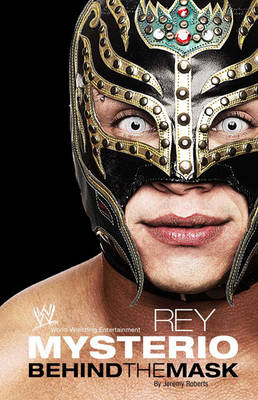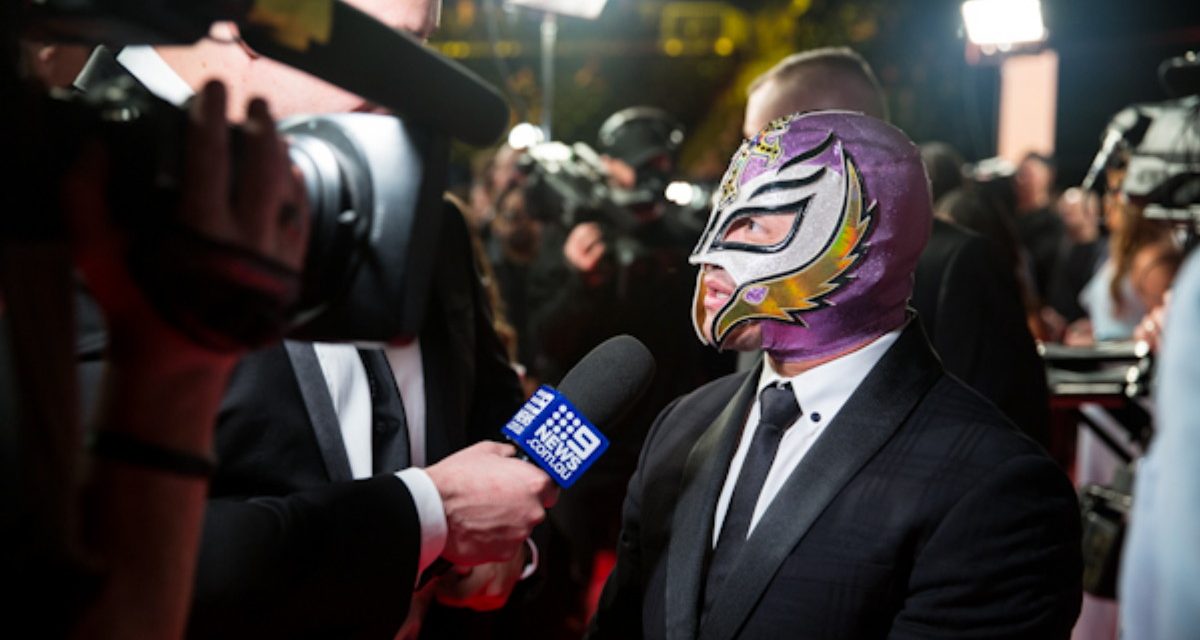Diehard WWE fans will want to add the just-released book, Rey Mysterio: Behind the Mask, to their library. Who wouldn’t want to find it sticking out of their DX merch Christmas stocking? But that doesn’t mean it’s a perfect book by any means. Having followed Mysterio’s career for decades, I feel compelled to address both its pluses and minuses.
The book overall is an enjoyable read, but some of the more important aspects of his life, like his long friendship with Chris Benoit, are tactfully avoided. Well, we didn’t expect that to be in there, it’s just jarring to the heart that it isn’t. For one of the smaller superstars (perhaps in stature but certainly not in his giant heart and skill set) to have accomplished so much, including a run as a WWE world champ, is truly amazing and deserving of a book. It’s a good book, a primer for casuals and newer, younger WWE fans to get up to speed on the real Óscar Gutiérrez and his high-flying roller coaster ride to his current stature within the company.

It’s interesting he (or co-author Jeremy Roberts) starts the book by discussing that he’ll simply refer to himself as Rey Mysterio (as opposed to Rey Mysterio/Misterio Jr.) and that from page one, he’ll refer to his company as WWE or “the company” to avoid confusion. Rey plays fair in also stating he won’t refer to any luchador by his real name unless they’ve already been unmasked. Roberts has previously written (or ghost-written) WWE Simon and Schuster books about Batista (Batista Unleashed) and WWE’s Showdowns: The Top 20 Rivalries in the Past 20 Years.
What’s Good
The discussions of his time in Mexico, his first gimmick as masked Colibri, how as a really small guy at the time he really had to fight just to get a try-out, and then fight to get a push besides getting noticed, were all great. But it all could’ve been even longer, including more details and some of the ribs and road stories he’s personally told me about — there’s always more “good stuff!”
His fans, old and new, will also enjoy reading about his at-length training with his uncle who was already an established name, including in the U.S. thanks to various promotions in Southern California such as Red Bastien’s syndicated “WIN” lucha libre TV show that aired in many major markets in the late ’80s and early ’90s. WIN was also the first mainstream TV exposure for Super Muneco, Eddy Guerrero and Konnan.
We learn of the behind-the-scenes fighting to avoid Eric Bischoff’s desire to get the masks off the luchadors that Konnan had brought to WCW, so they could show more facial reaction and blend in. There’s a nice chapter on his time in ECW and Konnan’s extreme group Aztecas in Tijuana entitled “Going Extreme.” I also learned some decent, new details about his family life as a husband and “Papi.” When Eddy, Benoit and later Rey won one of WWE’s world titles, we were all proud. And of course disappointed the title reign didn’t last longer. But in his book, Rey is philosophical about it and doesn’t appear to feel he’s hit the glass ceiling. I think most will enjoy his retelling about what he believes is the first time he ever met and shook Eddy’s hand, too. We learn a little about all the folks he met along his global career path, including Konnan, La Parka, Psycosis, the late AAA innovator Antonio Pena, plus his thoughts on CMLL’s Paco Alonso, Paul Heyman and everyone in ECW at the time. Not to be forgotten are the “wolfpak de hermanos” in Rey, Chris Jericho, Eddy, Art Barr, Vampiro and Norman Smiley.
It was a nice touch — especially during his recent medical crisis — that he also dedicated the book to his uncle Miguel (Rey Sr.) “who trained the hell out of me” besides his wife, children y familia. And that shot of him as Colibri at only 13 years old, posing in his gear with the legendary Tiniablas Sr. is great, bleached blond hair and all.
What Could Be Better (or in more detail)
We all know the drill in that the brunt of any book will focus primarily on one’s WWF/E career, which is smart on “the company’s” part, and just the way it is from a business standpoint. But there just was so much history in his specific work in Mexico and Japan, those first few Ron Skoler-purchased AAA shows in the early 1990s to the Los Angeles Sports Arena, Chicago UIC Pavilion and Madison Square Garden’s “Felt Forum.” There are not enough Art Barr in New York stories — at least for those of us who worked for Skoler and were there.
Rey has always been a totally polite, politically correct gentleman, sensitive of other’s feelings, so there’s really no dirt of any kind here for those who might crave that. But if you know Rey/Oscar, you’d know he’d never poison-pen anyone. He’s often said his parents taught him the right path in life — “that if you can’t say something good about someone, don’t,” although perhaps he’s seen and internalized enough things negative to offset the positives.
There could be more detail on the riots at some of the bigtime AAA and Konnan/Tijuana Aztecas shows: what caused them and how they were handled. And I’m sure some would want him to spill his guts on Dr. Phil Astin and his knowledge and/or involvement with the disgraced Atlanta doctor, sentenced for provided pills to athletes — including Mysterio. But that salacious-type material isn’t in this 358-page book.
Nor are there any digs at CMLL’s recent copycat creation in the young superstar Mystico, who with the colored contacts, 619 and similar moves absorbed into his repertoire really seems more like a Frankenstein Rey Jr. creation than even Rey Mysterio’s actual son, who wears a similar mask and gear and is tattooed in the same spots as his more famous cousin. Rey Sr.’s son earlier this year was reportedly advertised as “Rey Mysterio Jr.” rather than the more truth-in-advertising Hijo de Rey Mysterio Sr. I would’ve loved to have learned Rey’s thoughts on his cousin telling this reporter last year that he’d soon be going to WWE to team with Rey Jr. If Mystico isn’t coming to WWE, one would guess Rey Jr. doesn’t need, nor is having a lookalike come in to do a double Undertaker-type angle (however fun in the right hands that might play out).
I’m sure most who marvel at all the trendsetting and innovative moves and acrobatics that wow fans every night, won’t be surprised that there was an addiction to pain medication. Rey’s been doing what he does for many years, but since starting with WWF/E has more recently done it in a wiser, protective fashion.
And, like any book, there are a few errors that pop up that could have been avoided. Rey talks about the famed Tokyo restaurant “Rivera” when it is actually the Ribera steakhouse.
What’s Missing
There’s not enough text and detail (and photos) on his career before ECW, WCW and WWF. Although he talks quite a bit about Eddy (Eddie) Guerrero and “the impact Eddie made on his career in WWE,” the book would have been more satisfying with even more Eddy material like their time together in Mexico, Japan, ECW and WCW, plus more on Barr and, of course, Benoit. Not sure if there was any pressure to avoid the Benoit discussion, but there’s no mention of his long friendship with Chris, unlike in the non-WWE Chris Jericho autobiography, which faced it head-on.
He does talk about Eddy in the chapter “The Worst Day In My Life,” but a lot therein is on the Eddy/Papi angle involving his son, Dominik, and not the full meat of their long relationship. With so much of his life’s history with su hermanos (his brothers), Eddy, Art and Benoit for example, I’d loved to have read more.
Plus perhaps what he thinks about Mil Mascaras. There has to be a natural rivalry there, as Mysterio has supplanted Mil as the best known masked Luchador of the modern era from a global perspective. I know Mil in his long-promised book will be talking about it! (Note: Mil told me in 2005 he won’t write his own autobiography until he finally and totally retires from the ring, because he’s probably going to spill a lot of stuff that’s happened since 1962 over a much longer career.)
A full chapter on his thoughts about having to briefly heel — unmasked — in WCW would’ve been appreciated as well.
Overall, we’re all going to read this book and enjoy it for what it is. It should do very well in Europe and Japan, besides of course in North America. I’m anxious to see if it will be translated into Spanish for sale in a key current market for WWE.
The “mask” in this book is briefly removed, just too briefly for us to really see all that there is behind that mask.
RELATED LINK

